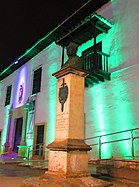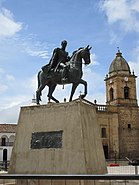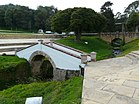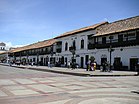Tunja
Tunja | |
|---|---|
Municipality and city | |
From the top: Main Cathedral, Bust of Juan de Castellanos in the Plaza de Bolívar de Tunja, Statue of Simon Bolivar in the main square, Bridge of Boyacá, Tunja Central Square and Panoramic from the north. | |
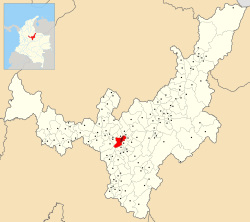 Location of Tunja in the department of Boyacá | |
| Coordinates: 5°32′N 73°22′W / 5.533°N 73.367°W | |
| Country | Colombia |
| Department | Boyacá |
| Province | Central Boyacá Province |
| Founded | 6 August 1539 (485 Years ago) |
| Established | March 29, 1541 |
| Founded by | Gonzalo Suárez Rendón |
| Government | |
| • Mayor | Mikhail Krasnov (2024-2027) |
| Area | |
• Municipality and city | 119.7 km2 (46.2 sq mi) |
| • Urban | 21.51 km2 (8.31 sq mi) |
| Elevation | 2,820 m (9,250 ft) |
| Population (2018 census)[1] | |
• Municipality and city | 172,548 |
| • Density | 1,400/km2 (3,700/sq mi) |
| • Urban | 163,894 |
| • Urban density | 7,600/km2 (20,000/sq mi) |
| • Metro | 243,330 |
| Demonym | Tunjano |
| Postal code | 150001-150009 |
| Area code | 57 + 8 |
| Website | http://www.tunja-boyaca.gov.co - https://www.tunjaculturayturismo.gov.co/inicio/ |
| IGAC - DANE - DIAN. | |
 |
| Part of a series on |
| Muisca culture |
|---|
| Topics |
| Geography |
| The Salt People |
| Main neighbours |
| History and timeline |
Tunja (Spanish pronunciation: [ˈtuŋxa]) is a municipality and city on the Eastern Ranges of the Colombian Andes, in the region known as the Altiplano Cundiboyacense, 130 km northeast of Bogotá. In 2018 the municipality had a population of 172,548.[1] It is the capital of Boyacá department and the Central Boyacá Province. Tunja is an important educational centre of well-known universities. In the time before the Spanish conquest of the Muisca, there was an indigenous settlement, called Hunza, seat of the hoa Eucaneme, conquered by the Spanish conquistadors on August 20, 1537. The Spanish city was founded by captain Gonzalo Suárez Rendón on August 6, 1539, exactly one year after the capital Santafé de Bogotá. The city hosts the most remaining Muisca architecture: Hunzahúa Well, Goranchacha Temple and Cojines del Zaque.
Tunja is a tourist destination, especially for religious colonial architecture, with the Casa Fundador Gonzalo Suárez Rendón as oldest remnant.[2] In addition to its religious and historical sites it is host to several internationally known festivals and is a jumping-off point for regional tourist destinations such as Villa de Leyva, Paipa, and Sierra Nevada del Cocuy. It is a stop on the Pan American Highway which connects Tunja to Bogotá and Santa Marta and eventually to the northern and southernmost parts of South America.
Demographics and geography
[edit]| 1500 | ~200,000[3] |
| 1636 | 50,000[3] |
| 1910 | 10,000 |
| 1928 | 19,000 |
| 1951 | 27,402 |
| 1962 | 68,905 |
| 1973 | 84,013 |
| 1985 | 93,245 |
| 1993 | 101,622[4] |
| 2005 | 152,419[5] |
| 2019 | 202,939 |
Tunja has a population of 172,548 inhabitants according to the 2018 Census. 0.1% of the city is indigenous, 0.4% is black, and 99.5% is white and Mestizo.[1] It is located in central Colombia, at an elevation ranging from approximately 2,700 metres (8,900 ft) to 2,900 metres (9,500 ft). The city centre is at an elevation of 2,820 metres (9,250 ft) above sea level.
Climate
[edit]Tunja's climate is influenced by its location and altitude. At almost 3000 m it is one of the higher cities in Colombia. As a result, the city features a subtropical highland climate (Köppen Cfb) with little variation in temperature throughout the year but a distinct dry season from December to February.
| Climate data for Tunja (Pedagogical and Technological University of Colombia), elevation 2,690 m (8,830 ft), (1981–2010) | |||||||||||||
|---|---|---|---|---|---|---|---|---|---|---|---|---|---|
| Month | Jan | Feb | Mar | Apr | May | Jun | Jul | Aug | Sep | Oct | Nov | Dec | Year |
| Mean daily maximum °C (°F) | 19.6 (67.3) |
19.8 (67.6) |
19.8 (67.6) |
18.7 (65.7) |
17.8 (64.0) |
16.8 (62.2) |
16.4 (61.5) |
16.7 (62.1) |
17.7 (63.9) |
18.3 (64.9) |
18.6 (65.5) |
18.8 (65.8) |
18.3 (64.9) |
| Daily mean °C (°F) | 13.3 (55.9) |
13.6 (56.5) |
13.9 (57.0) |
13.8 (56.8) |
13.5 (56.3) |
12.7 (54.9) |
12.2 (54.0) |
12.3 (54.1) |
12.7 (54.9) |
13.2 (55.8) |
13.4 (56.1) |
13.2 (55.8) |
13.1 (55.6) |
| Mean daily minimum °C (°F) | 7.3 (45.1) |
8.3 (46.9) |
9.0 (48.2) |
9.8 (49.6) |
9.8 (49.6) |
9.2 (48.6) |
8.6 (47.5) |
8.5 (47.3) |
8.2 (46.8) |
8.8 (47.8) |
9.0 (48.2) |
8.1 (46.6) |
8.7 (47.7) |
| Average precipitation mm (inches) | 18.1 (0.71) |
27.4 (1.08) |
53.5 (2.11) |
81.3 (3.20) |
85.2 (3.35) |
55.0 (2.17) |
49.1 (1.93) |
40.2 (1.58) |
50.0 (1.97) |
86.0 (3.39) |
73.9 (2.91) |
32.8 (1.29) |
652.5 (25.69) |
| Average precipitation days | 5 | 8 | 12 | 17 | 19 | 19 | 19 | 18 | 16 | 18 | 16 | 9 | 177 |
| Average relative humidity (%) | 75 | 75 | 76 | 80 | 82 | 83 | 83 | 82 | 79 | 79 | 80 | 78 | 79 |
| Mean monthly sunshine hours | 229.4 | 192.0 | 173.6 | 141.0 | 136.4 | 132.0 | 145.7 | 151.9 | 153.0 | 155.0 | 162.0 | 204.6 | 1,976.6 |
| Mean daily sunshine hours | 7.4 | 6.8 | 5.6 | 4.7 | 4.4 | 4.4 | 4.7 | 4.9 | 5.1 | 5.0 | 5.4 | 6.6 | 5.4 |
| Source: Instituto de Hidrologia Meteorologia y Estudios Ambientales[6] | |||||||||||||
History
[edit]Pre-Columbian era
[edit]The earliest evidence of human population on the Altiplano Cundiboyacense has been dated to approximately 12.000 years ago. Homus Tequendama inhabited the area by 6375 BCE. Archeologists have found human skeletons including arm bones in the area. Many archaeological discoveries were found in the area of the present-day city, dated to approximately 150 BCE.
During the 1st millennium AD, the territory was inhabited by the Muisca, who spoke Chibcha and emigrated from Central America through Panama to the Andean Region.[7] The Muisca developed their own religion, calendar and mythology.
According to those myths, it was the brutal cacique and prophet Goranchacha who moved the capital for the northern Muisca from Ramiriquí to Tunja, then called Hunza.
Early Muisca
[edit]
An era when frequent battles among cacicazgos took place, peace was proposed for the region and an agreement was made among caciques to choose a supreme chief to rule them all. Hunzahúa, who came from Ramiriqui, was elected. The capital of his confederation was named Hunza. Hunzahúa took the title of hoa ("great lord", the same meaning as psihipqua who ruled from Muyquytá), and reign over the lands from the Chicamocha to Fusagasugá and from the Llanos de San Juan to Panche and Muzo frontiers, including Vélez territory. This helped to unify the Muisca, especially with respect to their language and religion, until zipa Saguamanchica broke this unity due to differences with the cacique of Guatavita.[8]
Late Muisca (1490–1539)
[edit]
Saguamanchica, with 50,000 soldiers, decided on a massive attack on hoa Michuá,[9] crossing Guatavita and Chocontá, after which the Battle of Chocontá is named. Michuá dealt with him, supported by an army which doubled Saguamanchica, battling around three hours and killing both chiefs. A new hoa, Eucaneme, was installed, during the tense truce between Bacatá and Hunza.
In 1514, Eucaneme found out about the expansionist intentions of the new psihipqua Nemequene. He asked the caciques of Gámeza, Sugamuxi, Tundama and Sáchica to help him to reinforce his army. A battle was fought in Ventaquemada and, when Nemequene was about to become the victor, he was fatally wounded and his troops retreated. Iraca retracted his support and Eucaneme got a truce whose terms would end when the Spanish arrived. When Eucaneme found out the Europeans were around his lands, he decided to stay in Hunza and avoided any aggression against the invaders. He forbade under strict penalties to show the conquistadors the path to his headquarters and when he knew they were reaching him, he sent them gifts and peacemakers, hoping to stop them while he was hiding his treasures.
Hunza in Muisca history
[edit]| History of the Muisca | |||||||||
 | |||||||||
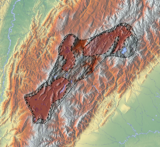 Altiplano |
 Muisca |
 Art |
 Architecture |
 Astronomy |
 Cuisine |
 El Dorado |
 Subsistence |
 Women |
 Conquest |
Spanish colony (1539-1811)
[edit]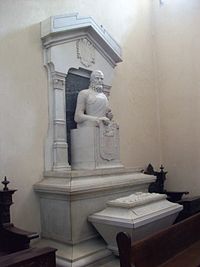
Spanish Discovering of Hunza (1537)
[edit]Gonzalo Jiménez de Quesada parted from Santa Marta in April 1536, on the first main expedition into the Andes. His main goal was to find and conquer El Dorado. After months of traveling, he found many Muisca cacicazgos in the Altiplano Cundiboyacense. In his search, he acquired information about emerald discoveries and other treasures in Somondoco and the Llanos. On August 20, 1537, the conquerors arrived, with horses and dogs. Jiménez de Quesada arrived at the headquarters of Quemuenchatocha, finding him in a chair, dressed in gold in the same way as his companions who ran off, leaving him alone. The gold, the emeralds and the fancy fabrics were taken. This conquest took place where later the San Agustin Convent was built. Quemuenchatocha was taken to Suesca, with the hope he would reveal where he hid the rest of his treasure. He abdicated in favour of his nephew Aquiminzaque and retired to Ramiriquí where he died.[10]
Invasion of Hunza (1538-1539)
[edit]The Spanish Invasion of the territory begins when Jimenez de Quesada captures Quemuenchatocha who is succeeded in life by the young Aquiminzaque. The latter, along with his tribe were taken as an encomienda by Hernán Pérez de Quesada. The new zaque did not show belligerent in front of the Spaniards, and later himself converted to Catholicism. The continuous and numerous demands made by the Spaniards started to create discomfort among the Muisca population.
Aquiminzaque should verify his nuptials with the daughter of the cacique of Gameza and many chiefs decided to go the solemn ceremony. A rumour came to Perez de Quesada that the occasion would be used as an insurrection, for which he apprehended Aquiminzaque and all the caciques, among them the ones from Toca, Motavita, Samacá, Turmequé and Sutamarchán, and condemn them to death. In 1540, the Zaque was beheaded and his death marked the end of the dynasty of zaques of Hunza.[11] In the same way, it points to the disintegration and dispersion of natives in encomiendas along the new Tunja Province.[12]
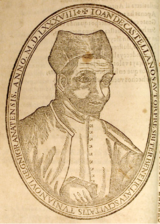
City Foundation (1539-16th Century)
[edit]The Spanish city of Tunja was founded on the lands of Quemuenchatocha, where later the convent of San Agustin was built. Founded by Captain Gonzalo Suarez Rendón, on August 6, 1539,[13] the main square was established, also a yard for the church and public buildings around the square; in 1550, the city outlines were consolidated. The same year, The franciscans arrive to the city, and the Dominicans a year later, the Augustinians in 1585 and the Jesuits in 1611; To the foundation, 77 yards are added and divided, along with 70 vegetable gardens, 11 estates and 44 stables. Only until 1616 two parishes are built to receive mestizos and Indians during colonial period: Santa Barbara, at southwest and Las Nieves, at north.[14]
This section needs expansion. You can help by adding to it. (December 2016) |
Security and living conditions
[edit]Tunja has the lowest homicide rate in Colombia and is below average in Latin America according to the report from the International Centre of the Prevention of Crime for 2010.[15][16] 2 homicides per 100,000 inhabitants in 2015 makes the city one of the safest in the Americas. According to other sources, this value is four times lower than the national average.[17] Tunja is an example of a safe city.[18]


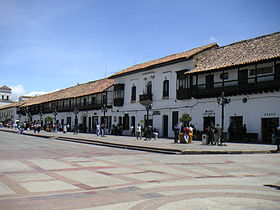



Tourism
[edit]Relevant historical and tourist sites
[edit]The streets are named according to 472[19] and Google Maps[20] nomenclatures — (C: calle), (K: carrera), (S: south), (E: east), (A: ave).
Southern Sector
| English Name | Spanish Name | Address |
|---|---|---|
| Bridge of Boyaca | Puente de Boyacá | Rural Area (La Lajita) |
| Flower Pot Monument | Los Tiestos | K14-C16 |
| Mushroom Monument | Los Hongos | A Oriental |
| St. Martin's Church | Iglesia de San Martín | Libertador Neighborhood |
| Bullfighting arena | Plaza de Toros | K8-C13S |
Eastern Sector
| English Name | Spanish Name | Address |
|---|---|---|
| Botanical Garden | Jardín Botánico | BTS Highway (Autopista Circunvalar BTS) |
| St. Anthony's Church | Iglesia de San Antonio | San Antonio Neighborhood |
| Governorate Viaduct | Viaducto Paseo de La Gobernación | BTS-A.Olímpica |
| JNN Viaduct | Viaducto Jose Nepomuceno Niño | C24-Universitaria |
Downtown
| English name | Spanish name | Address |
|---|---|---|
| Las Nieves Church and Square | Iglesia y Plazoleta de las Nieves | K10-C22 |
| St. Ignatius' Church | Iglesia de San Ignacio | K10-C18 |
| *St. Barbara's Church | Iglesia de Santa Bárbara | K11-C17 |
| St. Dominic's Church | Iglesia de Santo Domingo | K11-C19 |
| St. Laureano's Church | Iglesia de San Laureano | K9-C15 |
| St. Lazarus Hill and Church | Loma e Iglesia de San Lázaro | San Lázaro Neighborhood |
| St. Claire Royal Convent | Convento de Santa Clara la Real | K11-C21 |
| St. Francis Church | Iglesia de San Francisco | K10-21A |
| Cathedral Basilica of St. James the Apostle in Tunja[21] | Catedral Basílica Metropolitana Santiago de Tunja | Bolivar Square |
| Meetinghouse of the Church of Jesus Christ of Latter-day Saints | La Iglesia de Jesucristo de los Santos de los Últimos Días | C12-K10 |
| Our Lady of Miracles Church | Iglesia de Nuestra Señora del Milagro (El Topo) | K15-C19 |
| St. Augustine Cloister | Claustro de San Agustín | K9-C23 |
| Cojines del Zaque | Cojines del Zaque | K4-C12 |
| Republic Forest | Bosque de la República | K11-C14 |
| Freedom Obelisk | Obelisco de la Libertad | K10-C14 |
| City Founder Gonzalo Suárez Rendón House and Museum | Casa Museo del Fundador | Bolívar Square |
| Juan de Castellanos' Palace and Museum | Casa Museo Juan de Castellanos | Bolívar Square |
| Don Juan de Vargas' Palace and Museum | Casa Museo Don Juan de Vargas | K9-C20 |
| Bolivar Square | Plaza de Bolívar | K9-C19 |
| Tower Palace (Governorate Palace of Boyacá) | Palacio de la Torre | Bolívar Square K10-C20 |
| Rojas Pinilla's House | Casa Cultural Rojas Pinilla | K11-C16 |
| Martyr's Wall Monument | Paredón de los Mártires | K9-C14 |
| La Pila del Mono's Fountain | La Pila del Mono | K9-C20 |
| Royal Palace (currently a shopping mall) | Plaza Real | K14-C20 |
| St. Thomas University Building | Edificio Universidad Santo Tomás | K12-C19 |
| Santander Park | Parque Santander | A Colón |
| Pinzón Park | Parque Pinzón | K8-C23 |
| Maldonado Park | Parque Maldonado | C10-C30 |
| La Esperanza Park | Parque La Esperanza | |
| Hoyo del Trigo Park | Parque Hoyo del Trigo | C22-K12 |
Northern Sector
| English name | Spanish name | Address |
|---|---|---|
| St. Agnes' Church | Iglesia de Santa Inés | C42-A Norte |
| Hunzahúa Well | Pozo de Hunzahúa | A Norte, UPTC |
| Indigenous Race Monument | Monumento a la raza indígena | La Glorieta |
| Campus of the Uptc and its natural reserve | Campus de la Uptc y su reserva natural | A Norte, UPTC |
| Museum of Natural History | Museo de Historia Natural | A Norte, UPTC |
| Museum of Anthropology | Museo de Antropología | A Norte, UPTC |
| The Independence Stadium | Estadio de La Independencia | A Olímpica |
| Olympic Village | Villa Olímpica | A Olímpica |
Festivals
[edit]Shopping
[edit]Downtown
[edit]Main places of interest are:
- El Cid
- El Virrey
- Teatro Boyacá
- Cinema Boyacá
Shopping malls
[edit]Unicentro is a shopping center that features a Jumbo and a Cinemark Theatres among many other stores.
Viva, a brand of Shopping Centers of Grupo Éxito.
Traditional markets
[edit]- Plaza de Mercado del Norte
- Plaza de Mercado del Sur
Education
[edit]Relative to its small size, Tunja has been important in providing education. A large part of its population are students between high school and university.
Tunja has a considerable number of colleges, among these is the College of Boyacá, the first public school in the territories of Venezuela, Ecuador, Panama and Colombia, established when these countries were part of Gran Colombia. It was founded on 20 October 1822 by Vice President Francisco de Paula Santander. Among the most important schools are:
- Colegio de Boyacá
- Institucion Educativa San Jeronimo Emiliani
- Colegio Salesiano Maldonado
- Colegio INEM Carlos Arturo Torres
- Colegio de la Presentación
- Gimnasio Campestre del Norte.
- Colegio Municipal Silvino Rodríguez
- Escuela Normal Superior Santiago de Tunja.
- Escuela Normal Femenina "Leonor Álvarez Pinzón"
- Colegio Los Angeles
- Colegio Militar Juan José Rondón
- Colegio de Nuestra Señora del Rosario
- Colegio Gustavo Rojas Pinilla
- Colegio Andino
- Colegio American School Saint Frances
- Country Bilingual School
Universities
[edit]Tunja's major university, the Pedagogical and Technological University of Colombia (Uptc), was founded by General Gustavo Rojas Pinilla, and is one of the public universities in Colombia.
Other universities are:
- University of Boyaca
- Universidad Santo Tomás
- Escuela Superior de Administración Pública E.S.A.P.
- Universidad Nacional Abierta y a Distancia (UNAD)
- Fundacion Universitaria Juan de Castellanos
- Corporación Universitaria Remington (CUR-Cread Boyacá)
- Universidad Antonio Nariño
- Universidad Pontificia Bolivariana de Colombia
- Instituto Universitario de la Música y las Artes
Sports
[edit]The city has two professional football teams: Boyacá Chico and Patriotas F.C. The teams play in the Colombian Professional Football A league. They play their games at La Independencia Stadium in the north of the city.
The stadium was rebuilt for the Copa Libertadores 2009, expanding capacity to 20,630 spectators and meeting FIFA specifications. The city organized the 2008 South American U-20 Futsal Cup in which Brazil was awarded as the championship. Colombia secured the fourth position in the tournament.
The city has a professional basketball team called Patriotas that plays in the Saludcoop Invitational Cup. This team plays its matches in the Municipality Colosseum that has a capacity of up to 5,000 spectators.
Born in Tunja
[edit]- Jair Bernal, former professional cyclist
- Iván Casas, professional cyclist
- Francisca Josefa de la Concepción, Criollo nun
- Pedro Antonio Herrera, professional cyclist
- José Ibáñez, former professional cyclist
- Diego Molano Vega, politician
- Gustavo Nieto Roa, film director
- Juan Carlos Pinzón, ambassador of Colombia to the United States
- Gustavo Rojas Pinilla, former president of Colombia
- Diego de Torres y Moyachoque, 16th century mestizo cacique of Turmequé
Sister cities
[edit] Brazil: São Paulo
Brazil: São Paulo Ecuador: Guayaquil
Ecuador: Guayaquil Finland: Jyväskylä
Finland: Jyväskylä Ireland: Dublin
Ireland: Dublin Italy: Catania
Italy: Catania Italy: Potenza[25] (2009)
Italy: Potenza[25] (2009) Mexico: Tapachula
Mexico: Tapachula Peru: Juliaca
Peru: Juliaca Spain: Cádiz
Spain: Cádiz Spain: Málaga[26] (2013)
Spain: Málaga[26] (2013) Spain: Sevilla
Spain: Sevilla Spain: Toledo[26] (2013)
Spain: Toledo[26] (2013) Colombia: Pamplona[26] (2012)
Colombia: Pamplona[26] (2012) Colombia: Popayán[26] (2012)
Colombia: Popayán[26] (2012) Colombia: San Juan de Pasto
Colombia: San Juan de Pasto Colombia: Valledupar[27]
Colombia: Valledupar[27]
References
[edit]- ^ a b c Infomacion Capital (in Spanish) Retrieved November 17, 2022
- ^ (in Spanish) El Turismo: fuerza económica de Boyacá
- ^ a b https://dialnet.unirioja.es/descarga/articulo/7138162.pdf
- ^ http://www.dane.gov.co/index.php?option=com_content&view=article&id=437&Itemid=162 Censo 1964-1993
- ^ http://www.dane.gov.co/files/censo2005/regiones/boyaca/tunja.pdf CENSO 2005 DANE
- ^ "Promedios Climatológicos 1981–2010" (in Spanish). Instituto de Hidrologia Meteorologia y Estudios Ambientales. Archived from the original on 15 August 2016. Retrieved 17 June 2024.
- ^ "Los orígenes remotos de Tunja". Tunja.gov.co. Archived from the original on 7 July 2011. Retrieved 31 August 2011.
- ^ (in Spanish) Biography Hunzahúa - Pueblos Originarios
- ^ (in Spanish) Biography Michuá - Pueblos Originarios
- ^ (in Spanish) Biography of Quemuenchatocha - Pueblos Originarios
- ^ (in Spanish){http://pueblosoriginarios.com/biografias/aquiminzaque.html Biography of Aquiminzaque}
- ^ (in Spanish){https://web.archive.org/web/20110707053348/http://tunja.gov.co/?idcategoria=438 Nuestra Historia}
- ^ (in Spanish) Fundaciones de ciudades y poblaciones - Banco de la República
- ^ "Nuestra Historia". 2011. Retrieved 28 July 2011.
- ^ "Page officiel de la municipalité en espagnol". Tunja.gov.co. Retrieved 25 November 2017.
- ^ "International Centre of the Prevention of Crime, International report Crime prevention and Community safety: Trends and perspectives 2010". Crime-prevention-intl.org. Retrieved 25 November 2017.
- ^ Eduardo Posada Carb (21 January 2011). "Aprender de Tunja". El Tiempo.
- ^ "Inseguridad en las ciudades: ¿ficción o realidad?" [Insecurity in cities: fiction or reality?]. El Tiempo (in Spanish). 4 January 2011.
- ^ "codigopostal4-72.com.co". Codigopostal4-72.com.co. Retrieved 25 November 2017.
- ^ "Google Maps". Google Maps. Retrieved 25 November 2017.
- ^ "Catedral Basílica de Santiago Apóstol, Tunja, Boyacá, Colombia". Gcatholic.org. Retrieved 25 November 2017.
- ^ [1] Archived 2013-05-30 at the Wayback Machine
- ^ "Semana Santa". Tunja.gov.co. Archived from the original on 2011-07-07. Retrieved 2010-04-17.
- ^ "Aguinaldo Boyacense La Fiesta Grande de Boyacá para Colombia". Tunja.gov.co. Archived from the original on 2011-07-07. Retrieved 2010-04-17.
- ^ "Gobernación de Boyacá". Boyaca.gov.co. Retrieved 25 November 2017.
- ^ a b c d "Archived copy". Archived from the original on 2013-09-29. Retrieved 2013-09-29.
{{cite web}}: CS1 maint: archived copy as title (link) - ^ "Los Niños Vallenatos del "Turco" Gil - Nacimos para alegrar al mundo". Losninosvallenatos.com. Retrieved 25 November 2017.
External links
[edit]- (in Spanish) News from Tunja at Excelsio
- (in Spanish) News from Tunja at Mi Tunja.net


